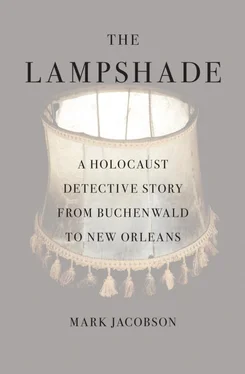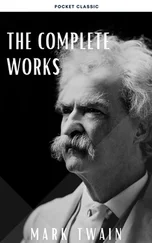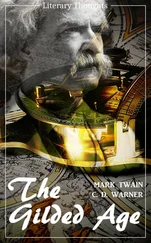If you knew whom to look for, you could see the architects of the deception at work, Denier Bud said. Episode eight of Dumb Dumb Evil focuses on two men seen in the Weimar march footage. One is a general, the star on his hat clearly visible, as he stands in the first row of the crowd mobbed around the Table. This individual, Denier Bud claims, “looks a lot like” Brigadier General Robert A. McClure, head of PWD. To the right of “McClure” is a bareheaded civilian standing in front of the Table holding up a human pelvis that SS officers had supposedly used as an ashtray. This man, Denier Bud claims, is C. D. Jackson, McClure’s second in command.
It is hard to see why the presence of either McClure or Jackson at the scene is so damning, being that SHAEF and the PWD units were clearly, and publicly, running the show at Buchenwald at the time. It is also worth noting that the book Psychological Warfare Against Nazi Germany: The Sykewar Campaign, D-Day to VE-Day by Daniel Lerner, from where Denier Bud has cribbed most of his information, makes no mention of either man being present at the camp that day. Still, the name C. D. Jackson is enough to perk up the ears of even the most moderate Cold War conspiracy buff.
Born in 1902, a Princetonian, at age twenty-nine chief assistant to Time-Life head Henry Luce, founder of the Council for Democracy (“to combat all the nazi, fascist, communist, pacifist” antiwar groups in the United States), U.S. ambassador to Turkey, appointed managing director of Time-Life’s international division in 1945, president of Radio Free Europe during the 1950s (including the period of the Hungarian revolt), Eisenhower’s speechwriter during both his presidential runs, U.S. delegate to the United Nations in 1954, described by Carl Bernstein as “Henry Luce’s personal emissary to the CIA,” named publisher of Life in 1960, a position from which he would purchase the famous 8 mm Zapruder film of the Kennedy assassination but never show it, and buy the life rights of Marina Oswald but never publish anything—this is one hell of a résumé, and that doesn’t even include setting up the American wing of the Bilderberg Conference.
For a paranoid of Denier Bud’s particular persuasion, the notion that the same man who bought and suppressed the Zapruder film had, nineteen years earlier, presided over the Buchenwald Table and handled the famous lampshade was akin to orgasmic. The vast movements of history were drawn in invisible ink. What joy it was to connect the dots, Denier Bud said, to link two of the great plots of the benighted, unlamented twentieth century—the Holocaust and the murder of John Kennedy. Even if it wasn’t C. D. Jackson standing beside the Buchenwald Table that day, the mere suggestion of the cold warrior’s presence at this paradigm-shifting moment in the octopuslike spread of American/Zionist intelligence—and the role of the Holocaust as a justification of much of that policy—that was still news, or art, Denier Bud insisted.
No doubt Denier Bud displayed a manic talent for conspiracy, but what did that say about the lampshade, if anything?
Some light was shed by another video posted on Denier Bud’s site, a tape of a 1994 Phil Donahue Show . With Schindler’s List just out, the relentlessly topical Donahue invited Bradley Smith, a noted “historical revisionist” and founder of the Committee for Open Debate on the Holocaust (CODOH), to talk about a series of ads he’d been placing in college newspapers defying anyone to prove that a single Jew had died in a gas chamber during World War II. Arguing the other side was Michael Shermer, then a professor at Occidental College and executive director of the Skeptics Society, which takes on the claims of “fringe groups” like Holocaust deniers.
To place the discussion in its proper context, it is important to know that 1994 was the undisputed high-water mark of what is generally referred to as “scholarly historical revisionism,” a phenomenon due in large part to the success of, and the resultant backlash to, Schindler’s List . But Holocaust denying can be said to have begun back in the late 1940s with the first published works of the French writer Paul Rassinier.
An enigmatic figure, Rassinier was born in 1906 into a left-leaning family known for their pacifist views. Having joined the French Communist Party as early as 1922, Rassinier served in the Foreign Legion in Morocco, where he witnessed events that strengthened his pacifist and anticolonial outlook. With the Nazi invasion of France, Rassinier joined the Resistance, often risking his life helping Jews escape from German territory into Switzerland. He was captured by the Gestapo in 1944 and sent first to Buchenwald and then north to the satellite camp at Dora-Mittelbau in the Harz Mountains where he labored in the underground work camp manufacturing, among other things, the V-2 rockets Hitler hoped would save his war effort. Returning after the war to France, where he was awarded the Rosette of the Resistance by Charles de Gaulle, a severely disabled Rassinier served briefly as a Socialist Party representative to the French National Assembly and later worked with Jean Cocteau, André Breton, and Albert Camus on various left-leaning political projects. During this time, however, he found himself in sharp disagreement with what he took to be misinformed and exaggerated accounts about the way the Nazi camps were run. Reports of mass gassing of prisoners at Buchenwald especially irked Rassinier. After all, Rassinier said, he was there, he knew that for all the cruelties of the camp—like a winch-driven pulley system devised by the SS to hang large “groups of guilty men at a time”—there were no gas chambers.
Rassinier’s first books, primarily The Lie of Ulysses, written in the early 1950s, established the basic “revisionist” canon: refuting the exterminationist gas chambers, questioning the widely cited death toll of six million, challenging the idea of German “intentionality,” and blaming the so-called genocide myth on Communists (from whom Rassinier had become seriously estranged) and Zionists who would use “a false picture” of Jewish misery to sway public opinion in favor of the creation of the State of Israel.
These views gained wider currency in the late 1970s with the U.S. publication of a number of Rassinier’s works, which were translated into English at the urging of Harry Elmer Barnes, a longtime Columbia history professor whose “America First” isolationist stance during the 1930s and ’40s allied him with Charles Lindbergh and other Nazi apologists. In 1978, with the founding of the Institute for Historical Review (IHR) by Willis Carto, a former youth organizer for George Wallace’s 1968 presidential campaign and would-be right-wing media mogul (he once owned the American Mercury, which years before had employed the journalistic hero and, alas, anti-Semite H. L. Mencken), Holocaust denying reached semi-think-tank status. A photo of an early IHR gathering showing twenty or so faux academics, some smoking pipes, might easily be mistaken for a still from a 1950s Madison Avenue adman convention or an early staff meeting at the Paris Review before the booze started flowing.
With funding provided by a reported $15 million endowment from Jean Farrel Edison, granddaughter of Thomas Edison, the organization’s Journal of Historical Review published “scholarly” articles by well-known deniers like Robert Faurisson, a French literature professor known for challenging the authenticity of Anne Frank’s diary. Other regular writers included the British historian David Irving, probably the best known of the revisionist academics owing to his widely publicized unsuccessful libel suit against American historian Deborah Lipstadt, author of Denying the Holocaust: The Growing Assault on Truth and Memory .
Читать дальше












